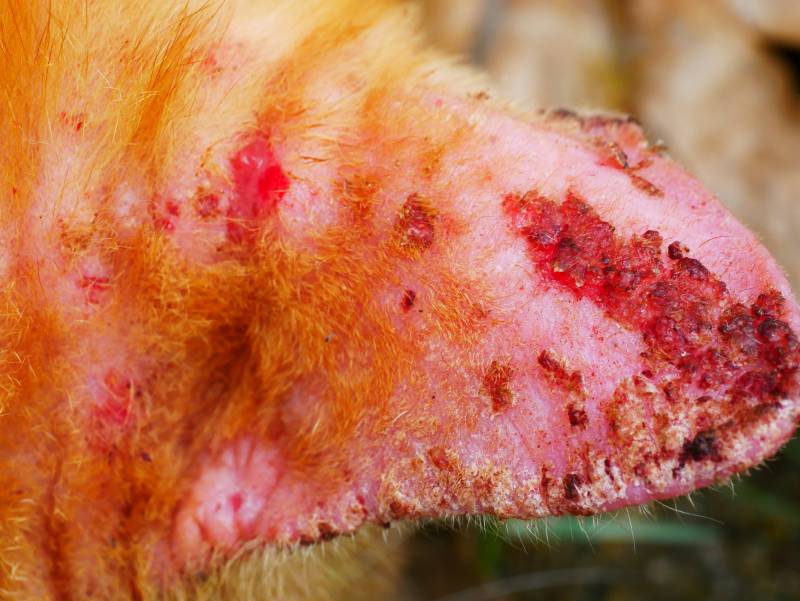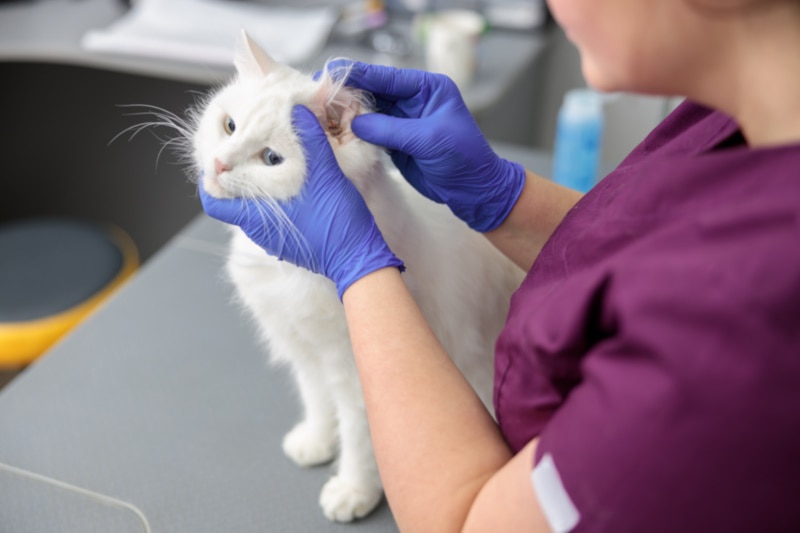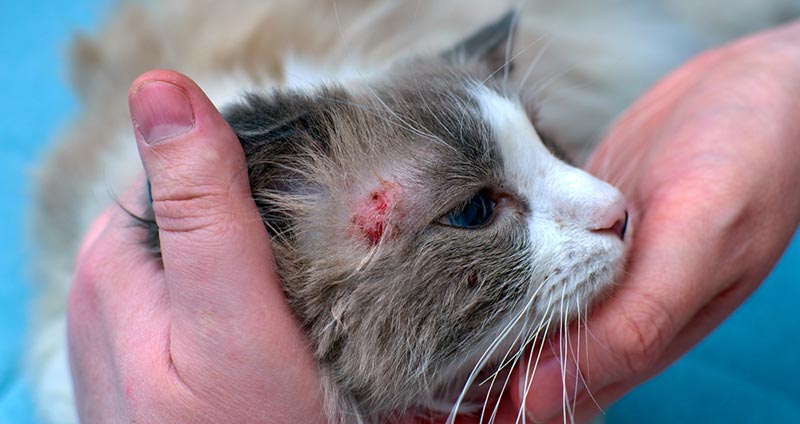
Click to Skip Ahead
Humans are not the only species that can get skin cancer. We can also see skin cancer in our beloved cats. While skin cancers are not the most common types of cancers we can see in cats, there are some important things to be aware of. In this article we will discuss what to look for as signs of skin cancer in your cat, what is considered staging, and how you may be able to treat your cat.
What Are the Most Common Skin Cancers in Cats?
“Skin cancer” is an umbrella term that can mean multiple different types of cancer. A cancer is when cells of the body abnormally grow, divide, and/or don’t die. Skin cancer just means that the skin is the area of the body where the cancer originated. Cancers can be benign (typically only grow in one area and don’t spread to other parts of the body) or malignant (can grow and/or spread to other body areas quickly). While your veterinarian may be able to look at your cat and “suspect” a certain type of cancer, there is no way to definitely know what type of skin cancer your cat has or doesn’t have without diagnostics. Below are some of the most common types of skin cancers we see in cats.
Squamous Cell Carcinomas (Abbreviated SCC)
This type of skin cancer is commonly related to excessive sun exposure. White, light colored, and hairless cats are at higher risk due to their skin having less protection from the sun. SCC can be found on the tips of the ears, nose, eyelids, face/neck. There is also an aggressive form of SCC commonly found in the mouth and nose of cats, but for the purpose of this article, we are referring to the SCC found on the skin.

Fibrosarcoma
These are the most common soft tissue tumors in cats. They can grow and spread extremely fast. They can start within the skin and quickly invade surrounding and/or underlying muscle, tissue, and organs. There are three forms of fibrosarcoma in cats – one form caused by a virus, one form not caused by a virus, and another potentially caused by vaccinations.
Basal Cell Tumor
These are more common in older cats, though any skin cancer can be seen in younger or older cats. Typically, these will start as single tumors and are often dark colored. Basal cell tumors can be benign but can also be a carcinoma, which is a type of malignant tumor.
Mast Cell Tumors (Abbreviated MCT)
Cats and dogs have normal inflammatory cells of the body called mast cells. These cells can sometimes grow and divide abnormally and create tumors. These tumors will form discrete tumors often found on the skin. Some cats can develop mast cell disease internally.

What Are the Signs of These Skin Cancers in Cats?
SCC
Squamous cell carcinomas of the skin commonly develop on the ears (especially the tips), eyelids, lips, nose, bridge of the nose, and in general, the mouth/face/neck. SCC are typically single tumors that start small, have irregular borders to the tumor and typically become ulcerated and oozing as time progresses. Approximately 1/3 of cats with SCC of the skin will have multiple lesions. If you notice an odor to your cat’s mouth, and they are having trouble chewing and/or closing their mouth, your veterinarian may suspect an SCC of the mouth.
Fibrosarcoma
This type of skin cancer typically appears as a solitary mass or tumor. These tumors will typically have a poorly circumscribed border (irregular border margins), are raised, and may become ulcerated or irritated on the surface. These tumors can invade surrounding and underlying tissues such as the muscle. Your veterinarian should be able to feel and move the tumor around and be able to suspect if there is invasion of other tissues aside from the skin.
Basal Cell Tumors
These tumors can be benign or malignant. They are typically firm, raised, hairless tumors typically found on the head and neck, though they can be found anywhere. These tumors are often pigmented. In other words, there is typically a color to the mass such as being brown or black in color.

Mast Cell Tumors
MCTs can range in size from small, pinpoint masses to larger tumors. They are often circular with well-defined borders. MCTs can be very itchy, and cats may lick and/or chew at them. Because they are made from the normal inflammatory cells of the body, these tumors can sometimes seem large and then shrink down in size if or when it’s actively inflamed.
What Is the Staging of Cat Skin Cancers?
Staging is the diagnosing and determining the extent of a cancer in your cat. First your veterinarian will need to diagnose the cancer. This can be done with either a needle aspirate and cytology, or biopsy with histopathology. The difference is that cytology only looks at cells that are collected in a needle/syringe, and histopathology looks at larger pieces of tissue. Depending on the type of cancer, special stains at the lab may be needed to determine the type of cancer that is seen under the microscope.
Once diagnosed, your veterinarian may also recommend an abdominal ultrasound, chest radiographs, or other types of imaging. These tools are used to determine if the cancer has spread to other places in the body. The radiographs will look at the lungs to see if there is evidence of metastasis in the lungs. The abdominal ultrasound will look at organs such as the spleen and liver for abnormal masses or appearance. If there are abnormal areas seen in or on other organs, these areas will likely also need to be tested, similar to the mass, to determine if they are the same type of cancer.
Surgery is commonly used to remove skin cancers. Staging is used to determine if surgery is possible, how extensive the surgery will be, and to know the extent of the cancer before, during and after surgery. These diagnostic tools will be used to monitor recurrence, regrowth, and/or uncured cancers even after surgery or other treatment is used.

How Do I Care for a Cat With Skin Cancer?
Skin cancers should all be monitored and treated by a veterinarian. Depending on many factors associated with skin cancer, your veterinarian may recommend surgical removal of the tumor(s). If your cat has surgery to remove a mass, you will need to keep your cat quiet and monitor the surgical site for any swelling, redness, and/or infection. Pain medications should be given as prescribed. Following surgery, your veterinarian will likely monitor both the surgical site and other sites for recurrence and/or regrowth of the cancer. Depending on the type of cancer, follow-up bloodwork, radiographs, or ultrasounds may be recommended.
Certain cancers may be susceptible to either chemotherapy or radiation therapy. Most chemotherapy agents can only be administered by a Board Certified Veterinary Oncologist. Your cat may need to be in the hospital for the day as the medication is given slowly. Other times the chemotherapy may be able to be given in a pill form. Radiation therapy has to be done in a specialty hospital and/or university setting. Your cat will need to be at minimum, sedated, but often will need to receive full anesthesia for their sessions. Both chemotherapy protocols and radiation protocols should be discussed with the Oncologist.
Frequently Asked Questions (FAQ)
How Is Skin Cancer Diagnosed in My Cat?
Skin cancer can only be diagnosed by testing the actual mass. Depending on the location of the mass, size of the mass and temperament of your cat, your veterinarian will discuss the best option for you. There is a way to aspirate the mass with a needle, spread those cells on a microscope, and send it to a lab. Your veterinarian may also want to take a tissue biopsy, or even just surgically remove the mass, and then send that tissue to a lab for diagnosis.

Will My Cat Die of Skin Cancer?
Unfortunately, some cancers can spread both locally and internally, and your cat can die from them. This all depends on the type of cancer, how old your cat is, where the cancer is, and how aggressive it is. Other times the cancer may have become so large that surgical removal is not an option. You may choose to have your cat humanely euthanized due to a poor quality of life.
Conclusion
Skin cancer comes in many shapes and sizes in cats. Your veterinarian cannot tell just by looking at a lump or mass if it is benign or malignant. Testing such as cytology or histopathology is needed for a diagnosis of the mass. Once diagnosed, your veterinarian will recommend additional testing to stage the cancer or determine the spread to other areas of the body. Surgery is typically the first step in treatment, with some cancers also needing chemotherapy and/or radiation therapy after. While surgery can be curative for some cancers, unfortunately others are so aggressive that your cat may succumb to the disease.
Featured Image Credit: Kiki vera yasmina, Shutterstock









